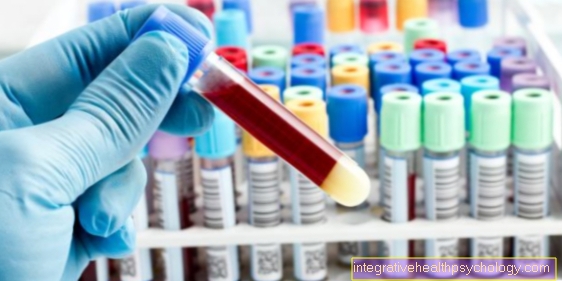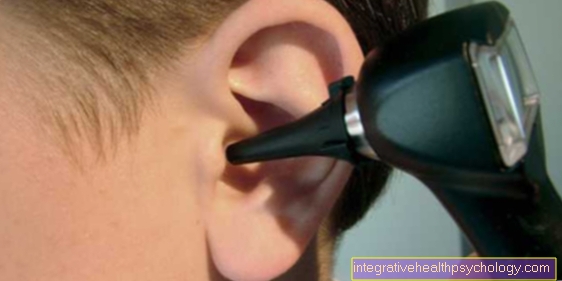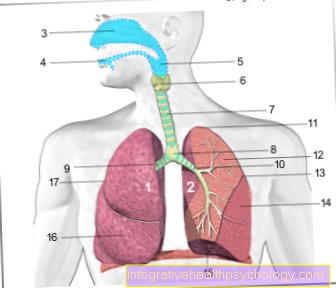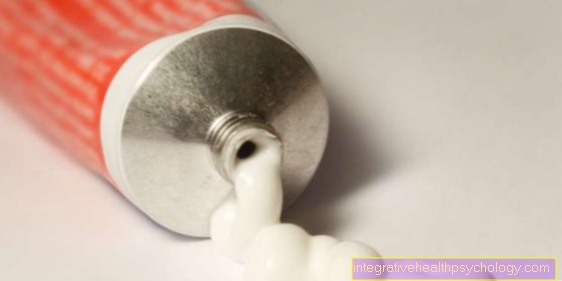Rapid hepatitis C test
What is a rapid hepatitis C test?
A rapid hepatitis C test is a test to detect specific antibodies against the hepatitis C virus. These tell you whether you have a hepatitis C infection or not. The test works with a small blood sample and can be evaluated after a few minutes. A number of tests for home use are available on the Internet. However, these tests are not to be considered reliable. If a hepatitis infection is suspected, it is better to see a doctor. On the one hand, this saves a lot of money and, on the other hand, a doctor must be consulted at the latest in the event of a positive home test to carry out a confirmatory test and initiate therapy.
Read more on this topic at: Hepatitis C test

Indications for a rapid hepatitis C test
Usually, hepatitis C runs without symptoms in the first phase of the disease. Clinical signs of infection include fatigue, lack of appetite, pain in the right upper abdomen, nausea, vomiting, and fever. If these symptoms occur, a test for hepatitis can be useful.
Read more on the subject at: Symptoms of hepatitis C.
A test for hepatitis C also makes sense for people who belong to a risk group. This includes people with drug use, especially if needles and other drug equipment were shared during use (“needle sharing”).
People who have unprotected sexual intercourse with frequently changing sexual partners also belong to the risk group for hepatitis C. The last risk group is medical personnel after a needlestick injury or after contact with the mucous membrane to potentially infectious secretions.
Read more on the subject at: Routes of transmission of hepatitis C.
When does a hepatitis C rapid test make no sense?
First of all, it should be pointed out again that performing a hepatitis C rapid test at home is not recommended. The test is not suitable for people who are not at risk as they are unlikely to develop illness.
However, if there is any doubt, it is advisable to have a reliable test carried out by a doctor. It also makes no sense to carry out a rapid hepatitis C test before a period of 10 weeks after the potential infection. Before that time, the amount of antibodies in the blood is not high enough to be sure.
Can I buy a rapid hepatitis C test from the pharmacy without a prescription?
So far, rapid tests for hepatitis C are not available in pharmacies. There are a few providers on the Internet who offer rapid hepatitis C tests. However, some of these are very expensive and are not considered reliable. If a hepatitis infection is suspected, a test should be carried out by a doctor or the health department. This test is usually much cheaper and the costs can even be covered by your health insurance.
Can you do this at home or is it only possible at the doctor's?
In principle, it is possible to carry out a hepatitis C test at home. However, this should be discouraged and a test should be carried out by a doctor or the health department instead. An exact and reliable result can be expected here. There is also the opportunity to provide information and advice about the disease and any treatment.
execution
Since the available tests each work differently, the enclosed instructions should always be followed.
In most tests, a lancet is used to place a small prick on a previously disinfected spot on the fingertip. The first drop of blood is wiped off and the next drop of blood is applied to the test strip. The blood now has to be mixed with the test solution. After a waiting time of about 20 minutes, the result can be read from the test strip.
Some tests show hepatitis in saliva instead of blood. Here, the saliva is applied to the test strip in the same way as the blood.
evaluation
Before reading the test result, care should be taken to wait about 20 minutes, depending on the test. Reading too early can lead to a false negative result.
The evaluation of the hepatitis C rapid test works in a similar way to a pregnancy test. Two lines may appear on the test strip. One is the control line. This should always appear, as a lack of it indicates that the test did not work. If the test result is positive, a second line appears.
Can the rapid test also be false positive?
A false positive result in a hepatitis C rapid test is possible. One possible explanation is that hepatitis C has already healed. In spite of the healing process, antibodies remain in the blood that are detected by the rapid test.
Also in the context of other infections such as EBV can lead to false positive test results.
Duration
The quick test usually takes a few minutes to complete. This is followed by a waiting time of around 20 minutes until the test result can be read.
It is important to note that in the event of an infection, the antibodies against the virus are only present in sufficient concentration after about 10 weeks to be detected by a rapid test. Therefore, there should be at least 10 weeks between the potential for infection and the execution of the test.
When should I repeat the hepatitis C rapid test?
A repetition of the hepatitis C rapid test does not really make sense in very few cases. If a first test is positive, a doctor should be consulted. He can carry out confirmation tests in the laboratory. The confirmatory test detects the genetic makeup of the virus and differentiates between a healed or an acute infection.
If the rapid test was carried out before the end of the 10 weeks after potential infection, a repeat test can be considered if necessary.
costs
The costs of a rapid hepatitis C test vary greatly depending on the provider. Some tests are offered on the Internet for over 100 euros.
However, if the test for hepatitis C is carried out by a doctor or health department, it is usually much cheaper. The costs are usually covered by the health insurance company.
What are the alternatives?
An alternative to a rapid hepatitis C test at home should always be to have the test carried out by a doctor. The test at the doctor or health department is safer and more reliable. The costs for the test are usually covered by the health insurance and the doctor can at the same time explain the disease and, if necessary, initiate treatment.





























